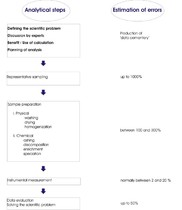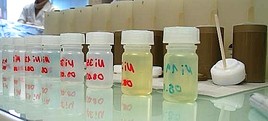Instrumental Analysis of Chemical Elements
Sampling Procedure
As is evident from the figure below, instrumental multi-element analysis of environmental samples can be derived into the following steps:
planning the analysis, representative sampling, sample preparation, the instrumental measurement of the analytical signal,
and evaluation of the data. In general each step of the analysis has a degree of error to which it is subject to error depends less on the chemical and physical propertes of the sample or substance
to be analyzed than it does on the concentration range in which the substance occurs in the sample (Horovitz 1988; Toelg 1976).
[please click on the figure]
Figure: Simplified flow chart of the instrumental multi-element analysis (Markert 1996).
Common problems are related to a representative sampling procedure which can introduce an error up to 1000 % if general rules of representative collection of the measuring samples will not be taken under strong consideration (Markert 1996).
It must be clearly stated, that instrumental measuring techniques are often an integrated part, especially when the parameter under investigation, f.e. the concentration of a trace metal, is considered. In both (instrumental and biotechniques) the sampling procedure is the essential part of the overall procedure. The sampling procedure has to be evaluated in between all (international) participants - at least of the actual investigation - to obtain comparability.
In the same way as the sampling procedure for instrumental measurements and biotechniques have to be under control, terms of precision (reproducibility) and accuracy (the “true” value) have to be checked with string standards during the overall monitoring procedure. We will not go in detail here but methods to observe precision and accuracy can be obtained in all textbooks of analytical sciences (see f.e. Markert 1996; Markert et al. 2003). Basically, two methods are now used to check the accuracy of analytical results.
1. The use of certified standard reference materials (commercially available samples with a certified content of the compound (f.e. a trace metal) to be measured and a matrix similar to the original samples to be measured in the laboratory).
2. The use of independent analytical procedures.
Please go ahead with Quality Control - The Terms Precision and Accuracy.
Back to Fields of Teaching, Research and Mangement.











